Analysis and Evaluation of Multi-Energy Cascade Utilization System for Ultra-Supercritical Units
Abstract
:1. Introduction
2. Thermodynamic Analysis and Evaluation Method
2.1. Basic Assumptions
2.2. Brief Introduction of Thermodynamic Calculation Method
3. New Boiler-Turbine Coupling Multi-Level Cascade Utilization System
3.1. Unit Introduction
3.2. Conventional Waste Heat Utilization System
- The heat transfer zone of the boiler-side AH is 25–360 °C, the hot end difference of the AH is 20–30 °C, and the cold end difference reaches up to 95 °C. The average heat exchange temperature difference is approximately 60 °C.
- In the AH, as the heat exchange progresses, the heat exchange temperature difference between the air and flue gas continuously increases. The air outlet of the AH reaches a maximum, and the heat loss of the AH and exergy loss are large. Thus, the flue gas waste heat utilization system must be further improved.
- The air temperature at the outlet of the AH is low, i.e., only 120 °C, and can be used to reduce the extraction steam amounts of No. 10 RH and No. 11 RH. Because the steam from the No. 10 RH and No. 11 RH is unsaturated steam and the temperature is low, the reduction in the part extraction steam working ability is limited. The energy saving effect is not significant.
3.3. Boiler-Turbine Coupling Multi-Level Cascade Utilization System
4. Energy Saving Analysis and Discussion of Multi-Level Cascade Utilization System in Ultra-Supercritical Unit
4.1. Boiler Island Energy Analysis
4.2. Analysis of the Extraction Steam System of the Turbine Island
4.3. Techno-Economic Analysis
5. Conclusions
- In terms of energy-saving, compared with the base system, for the new multi-level cascade heat utilization system, the decrement of the net heat rate is 91 kJ/kWh, the net efficiency increment is 0.79% and the decrement of net coal consumption is 3.3 g/kWh. In the new waste-heat saving system the thermal performance was significantly improved. For the conventional system, the decrement of net heat rate, the net efficiency increment, and net coal consumption decrement are 32 kJ/kWh, 0.4%, and 3.3 g/kWh, respectively.
- In terms of thermal economy, the new system exhibits remarkable energy saving effects and a short investment recovery period. Compared with the base system, the static payback period of the new system is 8.35 years and the annual cost decreases by 0.232 million USD on the base of the total plant investment increasing by 1168 million USD. Compared with a conventional system, the total plant investment of the unit is 2.6 times and the static recovery period is only 0.87 times.
- In the new waste-heat saving system the I LE inlet flue gas temperature is improved to 167 °C, 49 °C higher than the conventional system, which improves the heat exchange of the I LE by 47.5 MW. The energy saving of the flue gas bypass system is 29.2 MW. Due to heat exchange of the front air heater, the total energy-saving profit of the new system increased 3.4 MW compared with the conventional system. This result indicates that the comprehensive optimization of the waste heat utilization system is beneficial for the double reheat system because it provides significant benefits for the overall thermal performance and improves the techno-economic performance.
Author Contributions
Funding
Conflicts of Interest
References
- National Bureau of Statistics of the People’s Republic of China 2017 National Economic and Social Development Statistics Bulletin of China [EB/OL]. Available online: http://www.stats.gov.cn/tjsj/zxfb/201802/t20180228_1585631.html (accessed on 28 February 2018).
- Xu, S.X.; Wu, Z.X. Techincally Economical Analysis of Low Temperature Economizer Project of 1000 MW Unit. J. Shanghai Univ. Electr. Power 2014, 30, 94–100. [Google Scholar]
- Chen, L.; Sun, Y.Y.; Du, X.Z. Performance analysis of anti-corrosion heat exchangers made of special plastics for flue gas heat recovery. Proc. Chin. Soc. Electr. Eng. 2014, 34, 2778–2783. [Google Scholar]
- Wang, Z.P.; Chen, X.C.; Luo, T.K. Application of the WGGH in 1000MW Unit. Power Syst. Eng. 2017, 33, 46–48. [Google Scholar]
- Wen, Z.W.; Zhao, Z.L.; Gang, X.X. Research on Boiler Flue Gas Heat Recovery with Fluoroplastic Heat Exchangers. In Proceedings of the 2017 2nd International Conference on Energy, Power and Electrical Engineering (EPEE 2017), Shanghai, China, 26–27 November 2017; pp. 441–451. [Google Scholar]
- Zhang, Q.B.; Yang, J.G. Application study on enamel heat exchange tube in GGH of coal-fired unit with ultra-low flue gas emission. Therm. Power Gener. 2017, 46, 130–134. [Google Scholar]
- Li, Y.Y.; Han, Y.; Chen, Y.; Xu, G.; Yang, Y.P. A deep waste heat utilization system for utility boilers based on segmented air preheater design. Therm. Power Gener. 2016, 45, 41–47. [Google Scholar]
- Li, Y.Y.; Xu, G.; Xue, X.; Zheng, Q.Q.; Xu, C.; Yang, Y.P.; Key Laboratory of Condition Monitoring and Control for Power Plant Equipment of Ministry of Education. Thermodynamic analysis of the efficient flue gas waste heat utilization system with raw coal pre-dried of power plant. Proc. Chin. Soc. Electr. Eng. 2017, 37, 3498–3505. [Google Scholar]
- Han, Y.; Xu, G.; Yang, Y.P.; Xu, C.; Song, X. An optimized system for clean, efficient and deep utilization of flue gas waste heat from coal-fired power plants. J. Chin. Soc. Power Eng. 2015, 35, 674–680, 692. [Google Scholar]
- Han, Y.; Xu, G.; Yang, Y.P.; Li, Y. A Clean and Efficient Waste Heat Utilization System in Coal-fired Power Plants. Proc. Chin. Soc. Electr. Eng. 2016, 36, 5842–5848. [Google Scholar]
- Yue, Y.J.; Shen, S.L. Characteristics of European high-efficiency coal fired units and their implications for Chinese power plant. Electr. Power Constr. 2011, 32, 54–58. [Google Scholar]
- Song, J.H.; Kan, W.M.; Xu, C.; Xu, G.; Song, X.N. Comprehensive optimization of air preheater for boiler flue gas heat recovery. J. Chin. Soc. Power Eng. 2014, 34, 140–146. [Google Scholar]
- Shamsi, S.; Negash, A.; Cho, G.; Kim, Y.M. Waste Heat and Water Recovery System Optimization for Flue Gas in Thermal Power Plants. Sustainability 2019, 11, 1881. [Google Scholar] [CrossRef] [Green Version]
- Wang, Y.H.; Cao, L.; Li, X.C.; Wang, J.; Hu, P.; Li, B.; Li, Y. A novel thermodynamic method and insight of heat transfer characteristics on economizer for supercritical thermal power plant. Energy 2020, 191, 116573. [Google Scholar] [CrossRef]
- Zhao, Y.Z.; Pang, L.; Liang, X. Study on the Energy-saving Effect of Low-pressure Economizer System based on Energy Loss. J. Eng. Therm. Energy Power 2017, 32, 113–116. [Google Scholar]
- Xu, X.; Ju, G.D. Application and thermal economic analysis of plate low pressure economizer in flue gas waste heat recovery. In IOP Conference Series Earth and Environmental Science; IOP Publishing: Bristol, UK, 2019; Volume 291, p. 012025. [Google Scholar]
- Suresh, M.; Reddy, K.S.; Kolar, A.K. Thermodynamic optimization of advanced steam power plants retrofitted for oxy-coal combustion. J. Eng. Gas Turbines Power 2011, 133, 063001. [Google Scholar] [CrossRef]
- Ma, Y.F.; Yang, L.J.; Lu, J.F. Techno-economic comparison of boiler cold-end exhaust gas heat recovery processes for efficient brown-coal-fired power generation. Energy 2016, 116, 812–823. [Google Scholar] [CrossRef]
- Huang, B.; Xu, S.S.; Gao, S.W.; Liu, L.; Tao, J.; Niu, H.; Cai, M.; Cheng, J. Industrial test and techno-economic analysis of CO2 capture in Huaneng Beijing coal-fired power station. Appl. Energy 2010, 87, 3347–3354. [Google Scholar] [CrossRef]
- Liu, X.M. Engineering Economic Analysis; Peking University Press: Beijing, China, 2014. [Google Scholar]
- Hao, X.H. Comprehensive Waste Heat Utilization and Energy-Saving Analysis of the Low Temperature Flue Gas in Large-Scale Coal Fired Units. Ph.D. Thesis, North China Electricity Power University, Beijing, China, 2015. [Google Scholar]
- Electric Power Planning and Design Institute. Limitation Design Reference Cost Index of Thermal Power Engineering; China Electric Power Press: Beijing, China, 2009. [Google Scholar]
- Liu, Z.Z.; Li, Y.; Chen, X.H. Analysis of thermal economic benefits of first stage extraction location after reheat of reheat steam turbine set with outside steam cooler. Turbine Technol. 2004, 46, 382–384. [Google Scholar]
- Xu, G.; Jin, H.G.; Yang, Y.P.; Xu, Y.J.; Lin, H.; Duan, L.Q. A comprehensive techno-economic analysis method for power generation systems with CO2 capture. Int. J. Energy Res. 2010, 34, 321–332. [Google Scholar] [CrossRef]

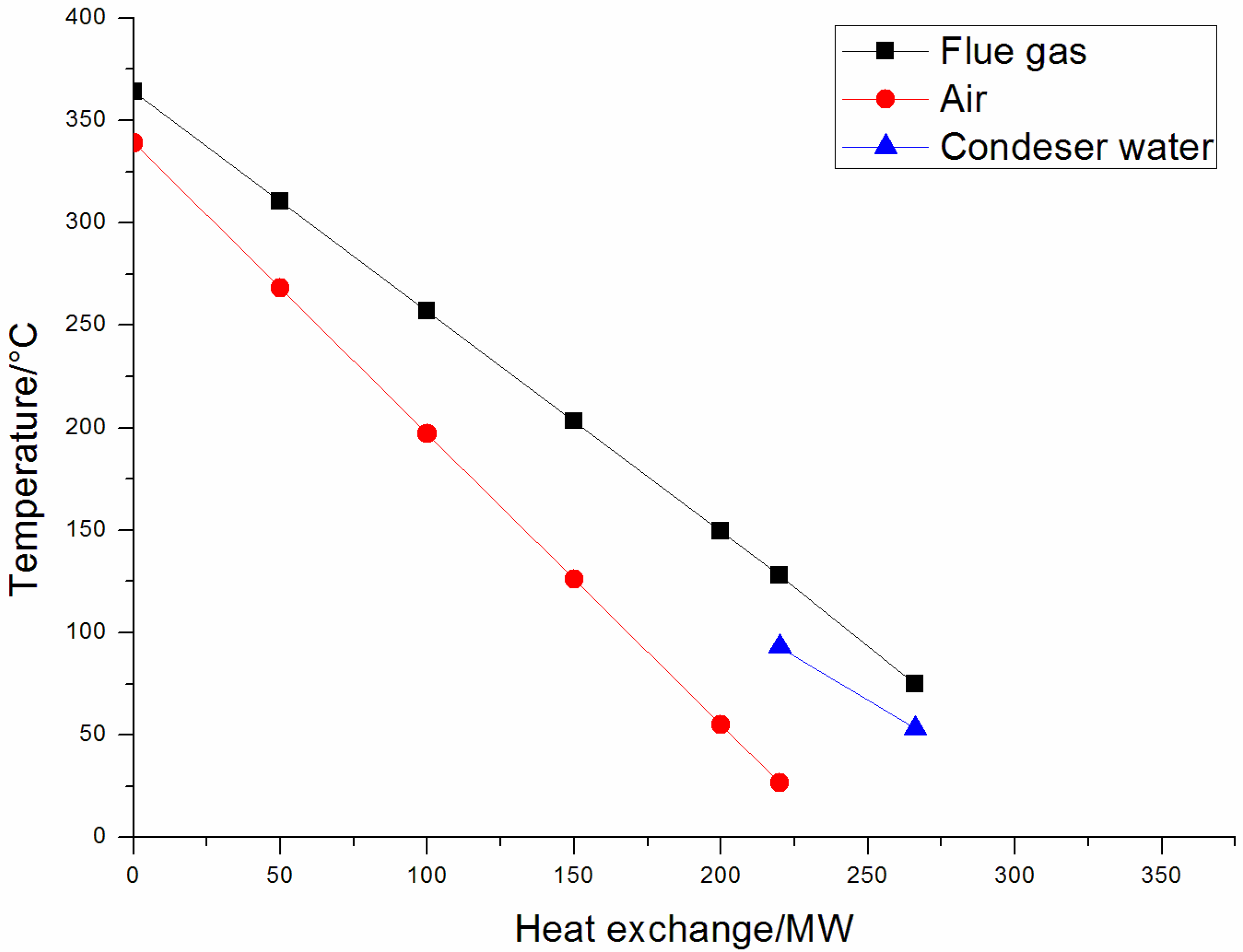

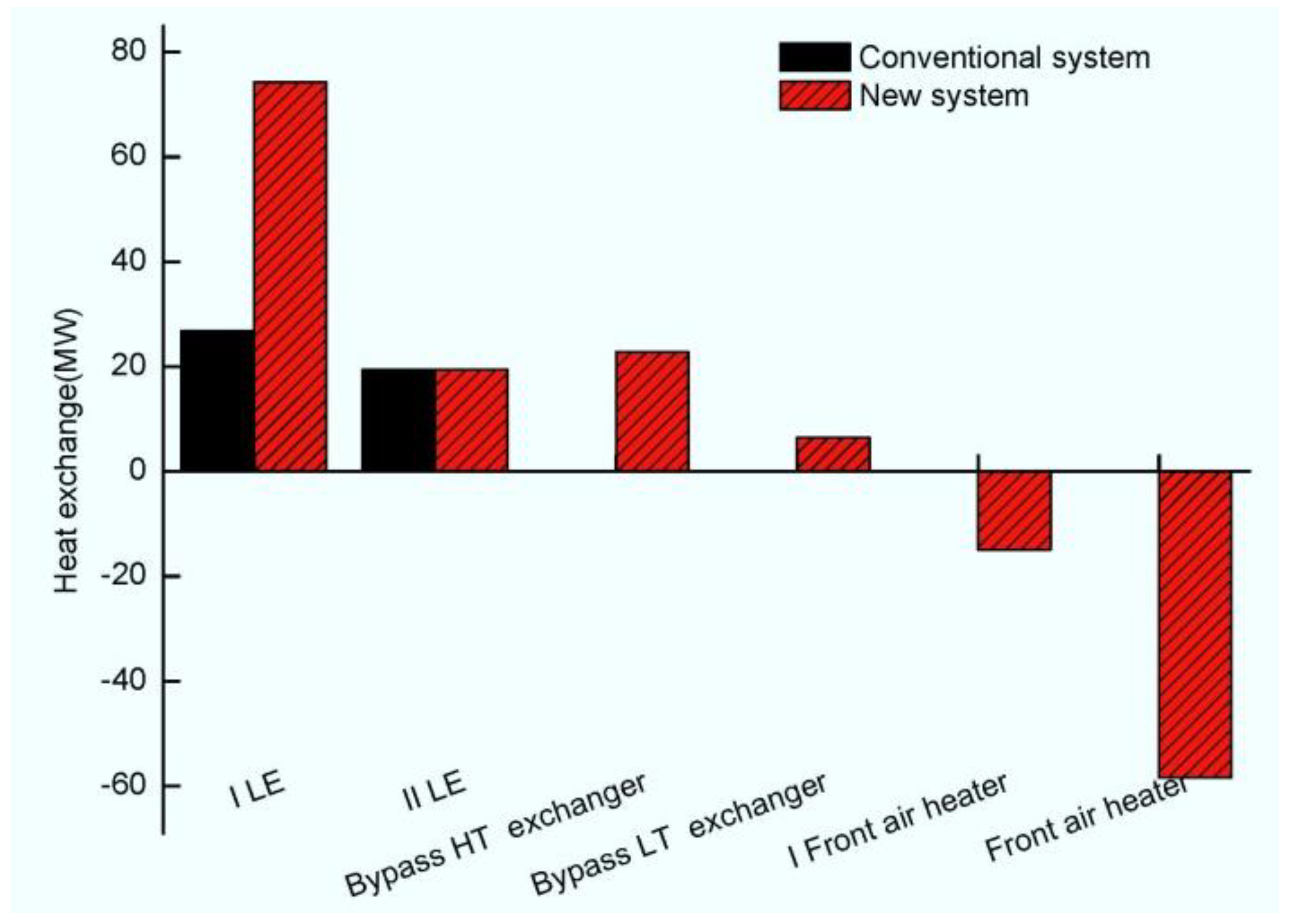
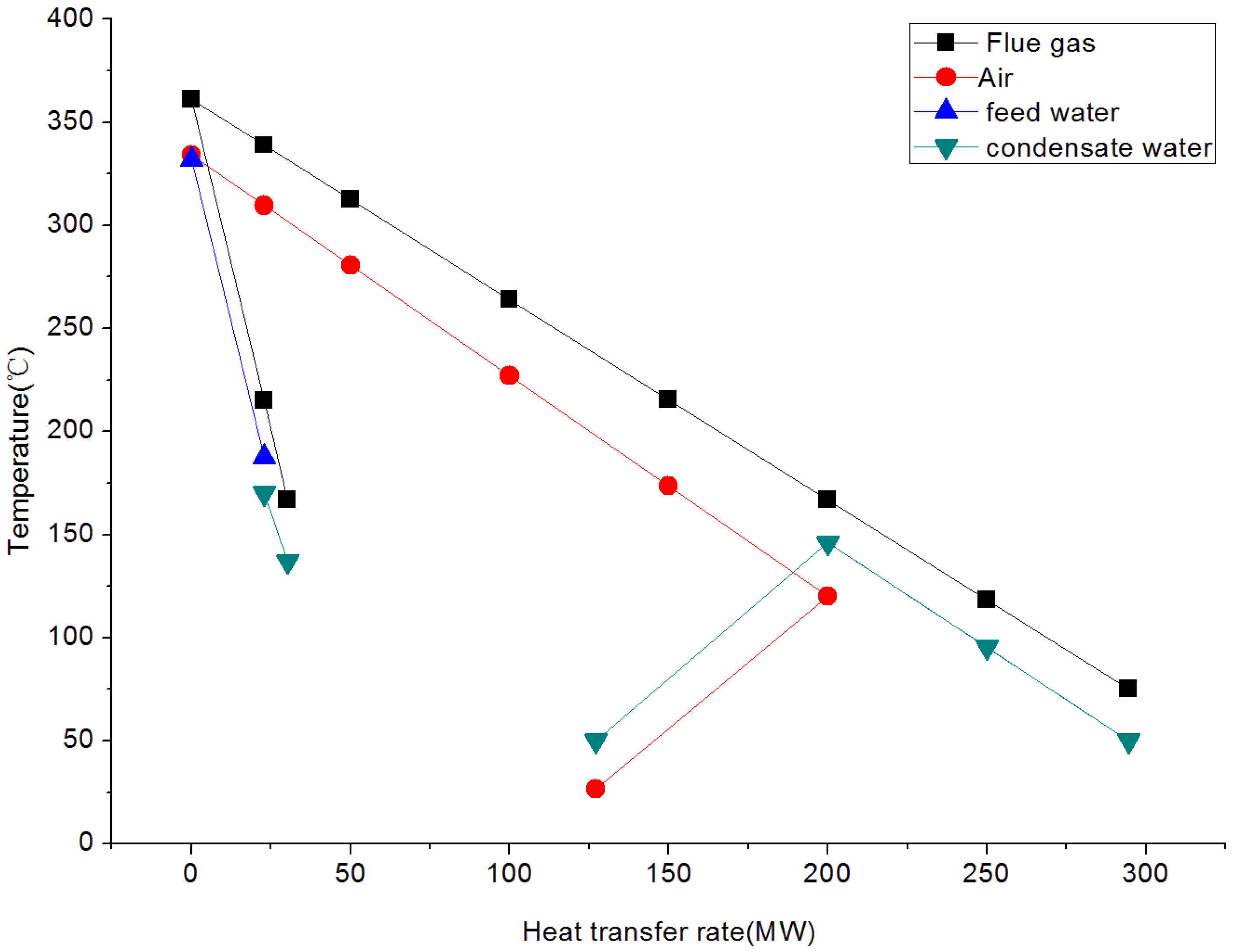
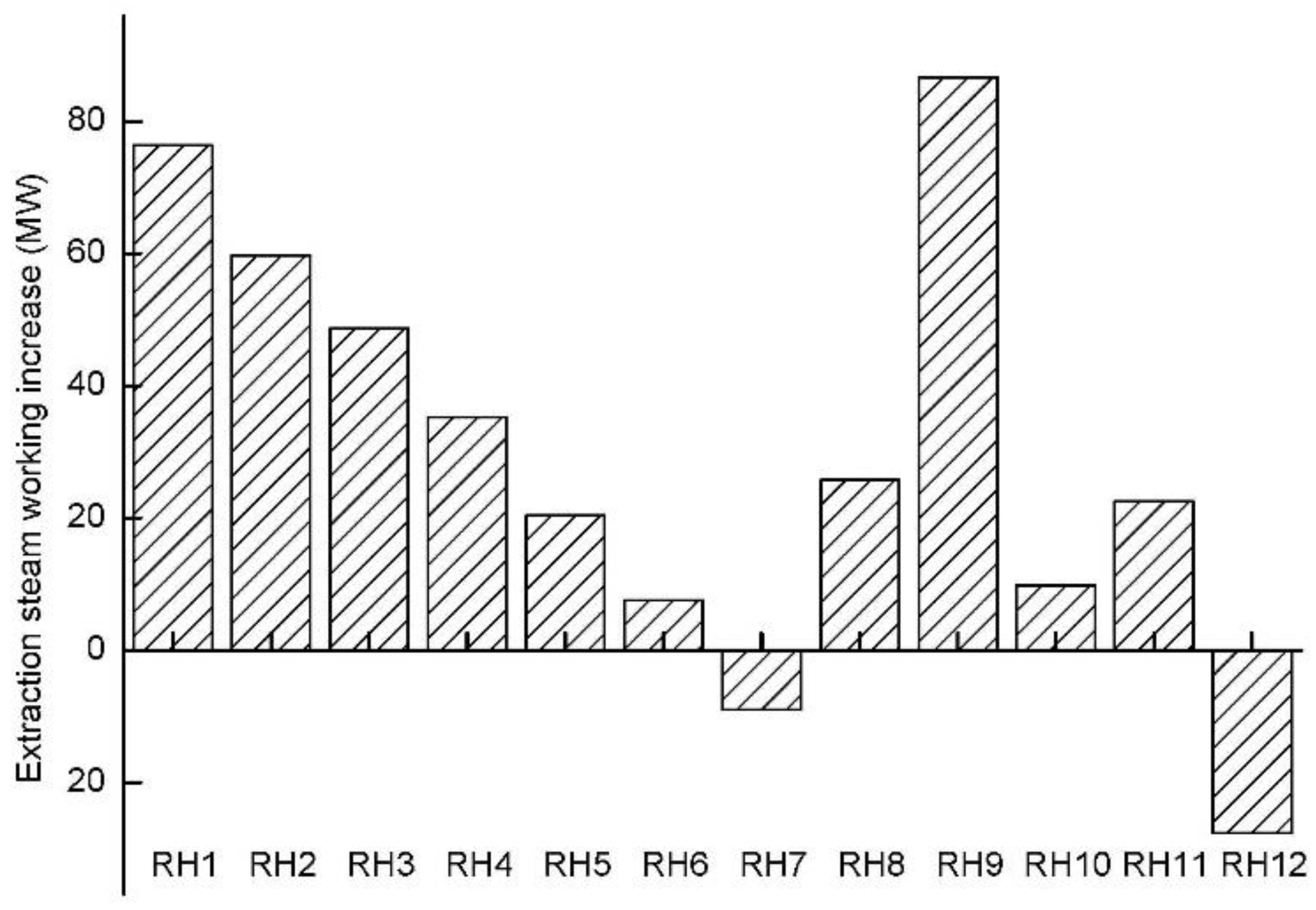
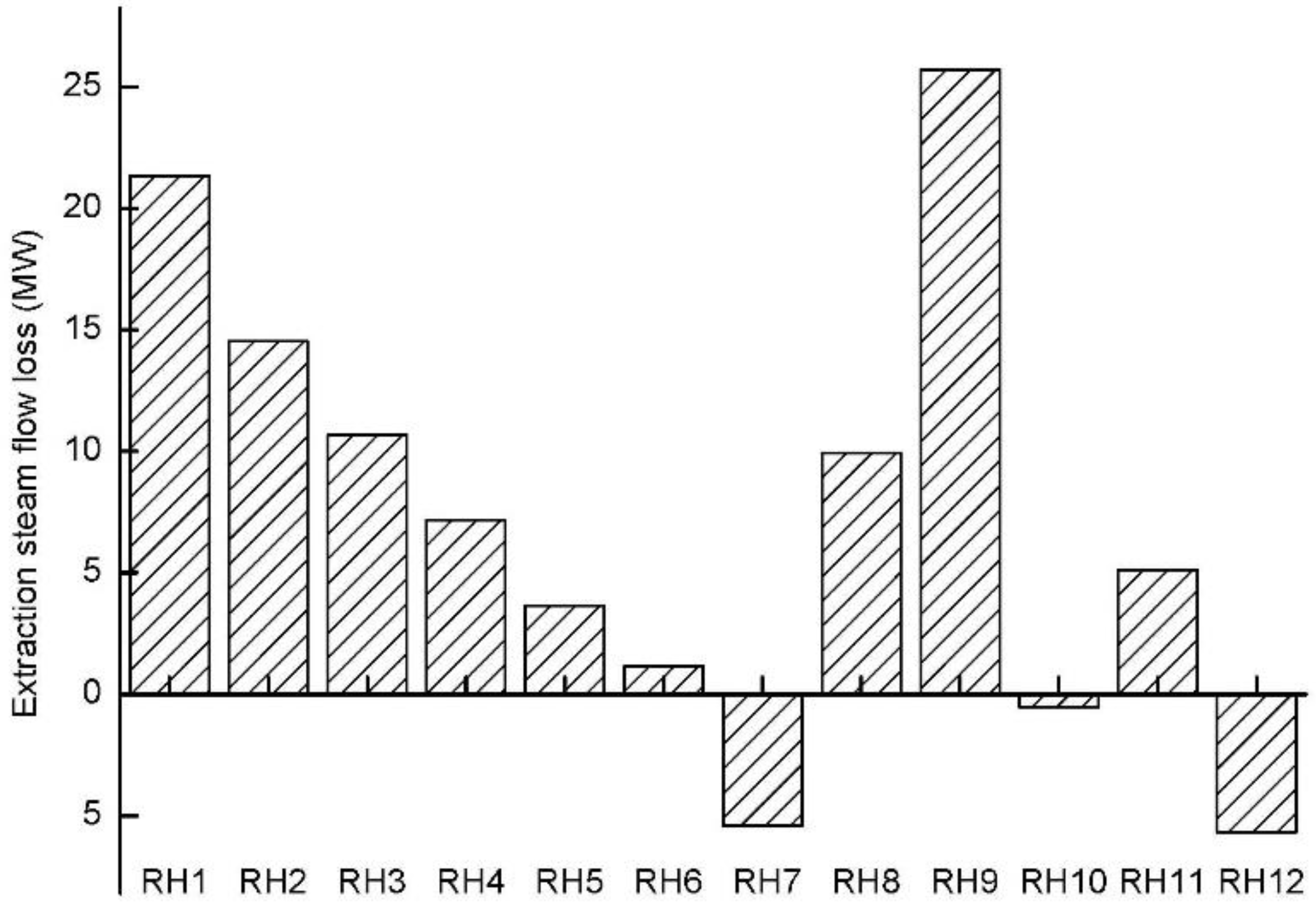
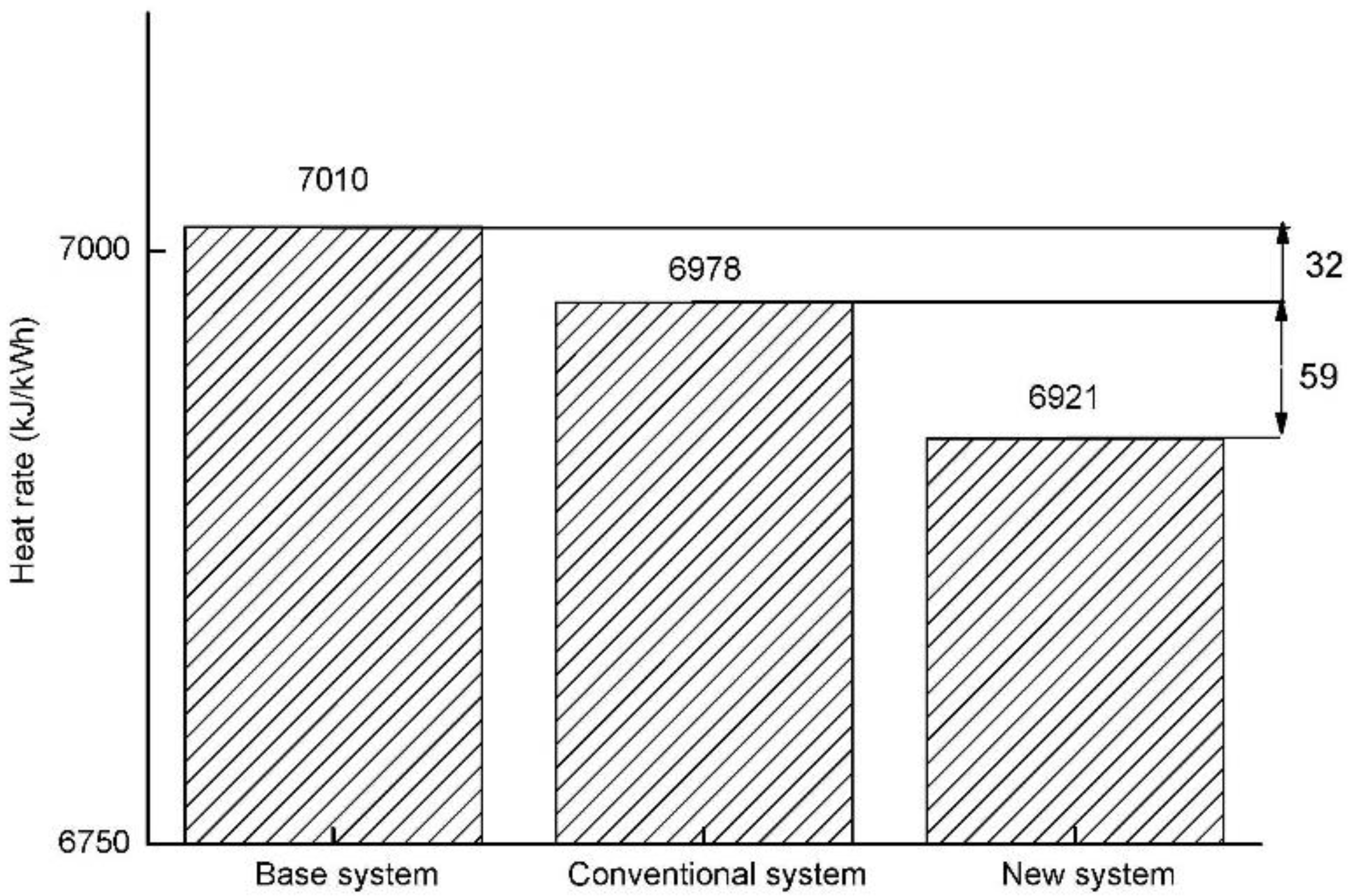
| Nomenclature | |||
|---|---|---|---|
| TMCR | turbine maximum continuous rating | DEA | Deaerator |
| AH | air heater | q | Hate rate (kJ/kWh) |
| CON | condenser | b | Parameters of boiler superheater |
| RH | Regenerative heater | p | mass flow rate of steam (kg/s) |
| CP | Comprehensive power of the unit | η | power generation efficiency |
| CAH | Cold air heater | h | enthalpy |
| FG | Flue gas | Q | power generation energy |
| LE | Low-temperature economizer | w | Boiler inlet feed water of boiler |
| Item | RH1 | RH2 | RH3 | RH4 | RH5 | RH6 |
|---|---|---|---|---|---|---|
| Extraction steam temp. (°C) | 457.3 | 412.4 | 357.3 | 303.3 | 249.8 | 205.1 |
| Extraction steam enthalpy (kJ/kg) | 3201.8 | 3138 | 3047 | 2956.8 | 2866 | 2778.4 |
| Extraction steam flow t/h | 193.7 | 188.5 | 158.5 | 133.67 | 117.9 | 76.6 |
| Outlet feed water tem. (°C) | 332.4 | 308.7 | 280.7 | 253.4 | 227.4 | 202.1 |
| Outlet feed water enthalpy (kJ/kg) | 1489.4 | 1367.6 | 1232.6 | 1106.5 | 990.5 | 880.2 |
| Inlet feed water temp. (°C) | 308.7 | 280.7 | 253.4 | 227.4 | 202.1 | 184.5 |
| Inlet feed water enthalpy (kJ/kg) | 1367.6 | 1232.6 | 1106.5 | 990.5 | 880.2 | 804.7 |
| Drain water temp. (°C) | 314.3 | 286.3 | 259 | 233 | 207.7 | 190.1 |
| Item | DEA | RH8 | RH9 | RH10 | RH11 | RH12 |
| Extraction steam temp. (°C) | 179.7 | 148.9 | 260.4 | 180.9 | 101.1 | 56.3 |
| Extraction steam enthalpy (kJ/kg) | 2686 | 2568.2 | 2990 | 2837 | 2684.9 | 2537.7 |
| Extraction steam flow t/h | 72.6 | 92.7 | 67.4 | 66.1 | 56 | 64 |
| Outlet condensate water temp. (°C) | 177.5 | 147 | 122.7 | 100 | 76.6 | 53.5 |
| Outlet condensate water enthalpy (kJ/kg) | 752.1 | 619.4 | 517.6 | 421.2 | 323.6 | 226.7 |
| Inlet condensate water temp. (°C) | 147.4 | 122.7 | 100 | 76.6 | 53.5 | 30.3 |
| Inlet condensate water enthalpy (kJ/kg) | 623.1 | 517.6 | 421.2 | 323.6 | 226.7 | 517.6 |
| Drain water tem. (°C) | -- | -- | 105.6 | 101.7 | 59.1 | 35.9 |
| Item | I LE | II LE | Air Heater |
|---|---|---|---|
| Flue gas percent (%) | 100 | 100 | 100 |
| Inlet flue gas temperature (°C) | 118 | 95 | 364 |
| Outlet flue gas temperature (°C) | 95 | 75 | 118 |
| Inlet water temperature (°C) | 70 | 53 | -- |
| Outlet water temperature (°C) | 93 | 70 | -- |
| Inlet air temperature (°C) | -- | -- | 26.6 |
| Outlet air temperature (°C) | -- | -- | 229 |
| Item | I/II LE (New System) | Bypass HT Exchanger | Bypass LT Exchanger | Air Heater | Front Air Heater |
|---|---|---|---|---|---|
| Flue gas percent (%) | 84 | 16 | 16 | 84 | -- |
| Inlet flue gas temperature (°C) | 167/95 | 361 | 215 | 361 | -- |
| Outlet flue gas temperature (°C) | 90/75 | 215 | 167 | 167 | -- |
| Inlet water temperature (°C) | 70/53 | 188.3 | 140 | -- | 145 |
| Outlet water gas temperature (°C) | 169/70 | 333 | 170 | -- | 50 |
| Inlet air temperature (°C) | -- | -- | -- | 120 | 30/25 |
| Outlet air temperature (°C) | -- | -- | -- | 333 | 120 |
| Item | RH1 | RH2 | RH3 | RH4 | RH5 | RH6 |
|---|---|---|---|---|---|---|
| Extraction steam temp. (°C) | 461.2 | 416.9 | 364.2 | 312.1 | 259.8 | 209.3 |
| Extraction steam enthalpy (kJ/kg) | 3208.6 | 3147.8 | 3060.6 | 2973.7 | 2884.9 | 2797.2 |
| Extraction steam flow (t/h) | 172.34 | 174 | 147.8 | 126.5 | 114.3 | 75.4 |
| Outlet feed water temp. (°C) | 332 | 310 | 283.2 | 256.9 | 231.6 | 206.2 |
| Outlet feed water enthalpy (kJ/kg) | 1487.6 | 1374.1 | 1244.5 | 1122.6 | 1008.8 | 898.2 |
| Inlet feed water temp. (°C) | 310 | 283.2 | 256.9 | 231.6 | 206.2 | 188.3 |
| Inlet feed water enthalpy (kJ/kg) | 1374.1 | 1244.5 | 1122.6 | 1008.8 | 898.2 | 821 |
| Drain water temp. (°C) | 315.6 | 288.8 | 262.5 | 237.2 | 211.8 | 193.9 |
| Item | DEA | RH8 | RH9 | RH10 | RH11 | RH12 |
| Extraction steam temp. (°C) | 183.4 | 150 | 262 | 182.7 | 102.9 | 57.3 |
| Extraction steam enthalpy (kJ/kg) | 2703.5 | 2575.9 | 2993.9 | 2840.4 | 2688.2 | 2540.3 |
| Extraction steam flow (t/h) | 78 | 82.8 | 66.6 | 61.6 | 50.8 | 69.6 |
| Outlet feed water temp. (°C) | 181.2 | 148.1 | 124 | 101.2 | 77.8 | 54.4 |
| Outlet feed water enthalpy (kJ/kg) | 768.3 | 624 | 523.1 | 426.8 | 328.4 | 230.6 |
| Inlet feed water temp. (°C) | 151.2 | 124 | 101.2 | 77.8 | 54.4 | 30.3 |
| Inlet feed water enthalpy (kJ/kg) | 639.1 | 523.1 | 426.8 | 328.4 | 230.6 | 129.9 |
| Drain water tem. (°C) | -- | -- | 106.8 | 102.9 | 60 | 35.9 |
| Performance Index | Basic System | Conventional System | New System |
|---|---|---|---|
| Net efficiency (%) | 48.6 | 49 | 49.39 |
| Net heat rate (kJ/kWh) | 7010 | 6978 | 6921 |
| Net coal consumption (g/kWh) | 252.8 | 251.6 | 249.5 |
| Decrement (g/kWh) | -- | −1.2 | −3.3 |
| Annual coal cost saving (million USD) | -- | −0.762 | −2.168 |
| Operation and maintenance cost (O&M, million USD) | -- | +0.0454 | +0.117 |
| Total plant investment (million USD) | -- | +4.54 | +11.68 |
| Annual operating cost (million USD) | -- | −0.605 | −1.738 |
| Annual cost (AC, million USD/year) | -- | −0.018 | −0.232 |
| Static payback period (NAR, year) | -- | 9.6 | 8.35 |
© 2020 by the authors. Licensee MDPI, Basel, Switzerland. This article is an open access article distributed under the terms and conditions of the Creative Commons Attribution (CC BY) license (http://creativecommons.org/licenses/by/4.0/).
Share and Cite
Chi, S.; Luan, T.; Liang, Y.; Hu, X.; Gao, Y. Analysis and Evaluation of Multi-Energy Cascade Utilization System for Ultra-Supercritical Units. Energies 2020, 13, 3969. https://doi.org/10.3390/en13153969
Chi S, Luan T, Liang Y, Hu X, Gao Y. Analysis and Evaluation of Multi-Energy Cascade Utilization System for Ultra-Supercritical Units. Energies. 2020; 13(15):3969. https://doi.org/10.3390/en13153969
Chicago/Turabian StyleChi, Shidan, Tao Luan, Yan Liang, Xundong Hu, and Yan Gao. 2020. "Analysis and Evaluation of Multi-Energy Cascade Utilization System for Ultra-Supercritical Units" Energies 13, no. 15: 3969. https://doi.org/10.3390/en13153969
APA StyleChi, S., Luan, T., Liang, Y., Hu, X., & Gao, Y. (2020). Analysis and Evaluation of Multi-Energy Cascade Utilization System for Ultra-Supercritical Units. Energies, 13(15), 3969. https://doi.org/10.3390/en13153969





